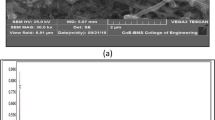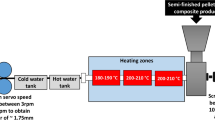Abstract
Buckypaper is a free-standing carbon nanotube (CNT) sheet used to improve handling and manufacturability of CNT-based nanocomposites. To enhance the mechanical properties and manufacturing efficiency of buckypaper, polymeric binders, such as poly(vinyl alcohol) (PVA), are often added into the CNT network during the manufacturing process. This paper describes a physics-based model to predict the elastic modulus of PVA-enhanced buckypaper and a statistical approach to calibrate and adjust the model based on physical experiments. Compared to the physics-based model alone, the hybrid model can provide more accurate predictions for the Young’s modulus of PVA-enhanced buckypaper and give a 95 % confidence interval on the prediction. One of the inputs for this model, the average length of carbon nanotubes, was calibrated using maximum likelihood estimation (MLE). The bias of this model was adjusted by estimating a bias function. Both the calibration parameter and adjustment function were estimated from a set of experimental measurements. The improvement in making a prediction was validated by comparing the performance of the physics-based model, statistical model, and statistics-enhanced physics model at a new experiment point. The hybrid model provides a more accurate prediction than either the physics-based model or statistical model does. This model calibration technique provides an effective tool for nanomanufacturing process design and material property prediction.
Similar content being viewed by others
References
Jones DEH (1996) Science of fullerenes and carbon nanotubes—Dresselhaus, MS, Dresselhaus, G, Eklund,PC. Nature 381(6581):384
Pham GT et al (2008) Mechanical and electrical properties of polycarbonate nanotube buckypaper composite sheets. Nanotechnology 19(32):325705
Yakobson BI, Smalley RE (1997) Fullerene nanotubes: C-1000000 and beyond. Am Sci 85(4):324–337
Thostenson ET, Ren ZF, Chou TW (2001) Advances in the science and technology of carbon nanotubes and their composites: a review. Compos Sci Technol 61(13):1899–1912
Harik VM (2002) Mechanics of carbon nanotubes: applicability of the continuum-beam models. Comput Mater Sci 24(3):328–342
Kukovecz A et al (2008) Multiwall carbon nanotube films surface-doped with electroceramics for sensor applications. Phys Status Solidi B Basic Solid State Phys 245(10):2331–2334
Chen IWP et al (2010) Charge-induced asymmetrical displacement of an aligned carbon nanotube buckypaper actuator. Carbon 48(4):1064–1069
Kang IP et al (2006) A carbon nanotube strain sensor for structural health monitoring. Smart Mater Struct 15(3):737–748
Suppiger D, Busato S, Ermanni P (2008) Characterization of single-walled carbon nanotube mats and their performance as electromechanical actuators. Carbon 46(7):1085–1090
Park JG et al (2009) Electromagnetic interference shielding properties of carbon nanotube buckypaper composites. Nanotechnology 20(41):415702
Simien D et al (2008) Influence of nanotube length on the optical and conductivity properties of thin single-wall carbon nanotube networks. ACS Nano 2(9):1879–1884
Coleman JN et al (2003) Improving the mechanical properties of single-walled carbon nanotube sheets by intercalation of polymeric adhesives. Appl Phys Lett 82(11):1682–1684
Joseph VR, Melkote SN (2009) Statistical adjustments to engineering models. J Qual Technol 41(4):362–375
Xiong Y et al (2009) A better understanding of model updating strategies in validating engineering models. Comput Methods Appl Mech Eng 198(15-16):1327–1337
Cox HL (1952) The elasticity and strength of paper and other fibrous materials. Br J Appl Phys 3(Mar):72–79
Kallmes O, Perez M, Bernier G (1978) Mechanistic theory of the load-elongation properties of paper-descriptive summary. Paper Technol Ind 19(9):311–312
Lu W, Carlsson LA (1996) Micro-model of paper. Part 2: statistical analysis of the paper structure. Tappi J 79(1):203–210
Goudsmit S (1945) Random distribution of lines in a plane. Rev Mod Phys 17(2-3):321–322
Miles RE (1973) Various aggregates of random polygons determined by random lines in a plane. Adv Math 10(2):256–290
Sastry AM, Wang CW, Berhan L (2001) Deformation and failure in stochastic fibrous networks: scale, dimension and application. Probabilistic Methods Fatigue Frac 200:229–250
Cheng X et al (1999) Investigation of failure processes in porous battery substrates: part II—simulation results and comparisons. J Eng Mater Technol-Trans ASME 121(4):514–523
Wang CW, Sastry AM (2000) Structure, mechanics and failure of stochastic fibrous networks: part II—network simulations and application. J Eng Mater Technol-Trans ASME 122(4):460–468
Berhan L et al (2004) Mechanical properties of nanotube sheets: alterations in joint morphology and achievable moduli in manufacturable materials. J Appl Phys 95(8):4335–4345
Berhan L, Yi YB, Sastry AM (2004) Effect of nanorope waviness on the effective moduli of nanotube sheets. J Appl Phys 95(9):5027–5034
Zaeri MM et al (2010) Mechanical modelling of carbon nanomaterials from nanotubes to buckypaper. Carbon 48(13):3916–3930
Box GEP, Hunter WG (1962) Useful method for model-building. Technometrics 4(3):301
Chen W et al (2006) Some metrics and a Bayesian procedure for validating predictive models in engineering design. In: ASME 2006 International Design Engineering Technical Conferences and Computers and Information in Engineering Conference. American Society of Mechanical Engineers
Reese CS et al (2004) Integrated analysis of computer and physical experiments. Technometrics 46(2):153–164
Kennedy MC, O'Hagan A (2001) Bayesian calibration of computer models. J R Stat Soc Ser B Stat Methodol 63:425–450
Easterling RG, Berger JO (2002) Statistical foundations for the validation of computer models. In: Computer Model Verification and Validation in the 21st Century Workshop, Johns Hopkins University. Citeseer
Hasselman T et al (2005) A case study in model improvement for vehicle crashworthiness simulation. In: 23rd International Modal Analysis Conference
Wang SC, Chen W, Tsui KL (2009) Bayesian validation of computer models. Technometrics 51(4):439–451
Author information
Authors and Affiliations
Corresponding author
Rights and permissions
About this article
Cite this article
Wang, K., Vanli, A., Zhang, C. et al. Calibration and adjustment of mechanical property prediction model for poly(vinyl alcohol)-enhanced carbon nanotube buckypaper manufacturing. Int J Adv Manuf Technol 88, 1889–1901 (2017). https://doi.org/10.1007/s00170-016-8898-4
Received:
Accepted:
Published:
Issue Date:
DOI: https://doi.org/10.1007/s00170-016-8898-4




